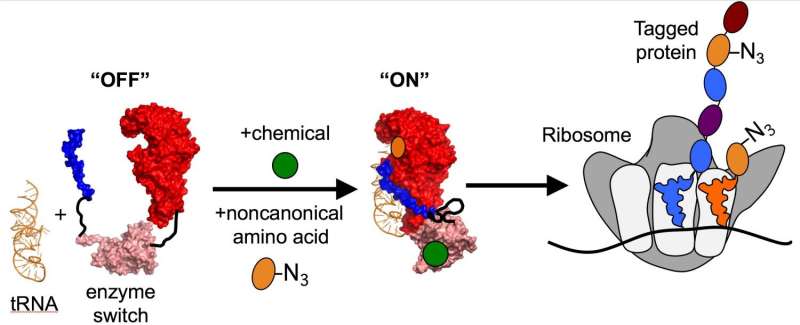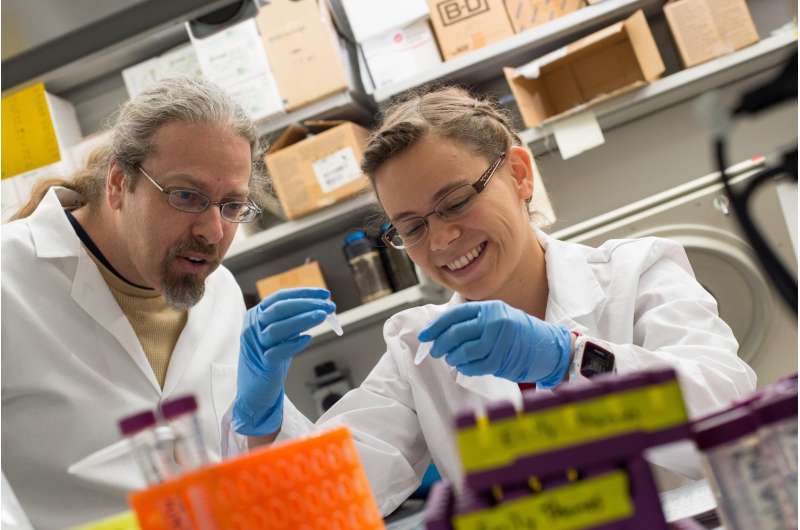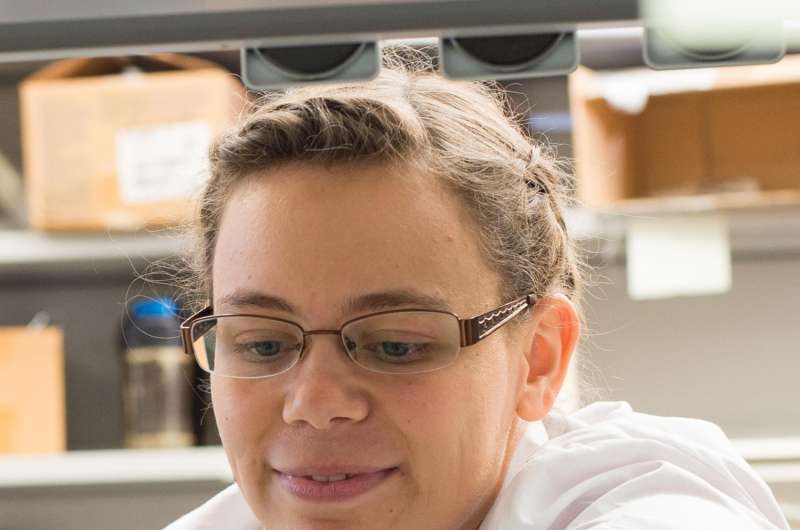Researchers build a novel switch to facilitate tagging of proteins in a cell

Rice University scientists have learned to spy on cells with a divide-and-conquer strategy to label proteins.
Graduate student Emily Thomas, synthetic biologist Jonathan Silberg and their colleagues built upon established techniques that attach bio-orthogonal (noninterfering), artificial amino acids to transfer RNA (tRNA), which are used by ribosomes to synthesize proteins.
Because the amino acids are "noncanonical," they are effective tags that help researchers identify proteins being synthesized in a cell. The Rice lab's breakthrough was the discovery of a tRNA synthetase that only adds the amino acid to the tRNA when it binds a chemical. When prompted, the tRNA synthetase charges a tRNA with the bio-orthogonal amino acid, which is then used by ribosomes to insert the tag into proteins made in the cell.
The study appears in the American Chemical Society journal ACS Synthetic Biology.
These bio-orthogonal tags give researchers a snapshot of total protein synthesis in the cell. "Instead of physically separating a cell from a mixture to find the proteins being made, we can use this engineered switch to put what amounts to a fishhook on every protein in a specific cell," Silberg said. "This approach will allow us to increase spatial and temporal control over the tagging of proteins synthesized in a given cell."

Since many proteins appear and disappear during the development of an organism or the spread of a disease, the technique could be helpful to identify cellular changes that underlie disease. Thomas characterized her technique as a "protein spy."
"It spies on what proteins are being made inside the cell," she said. "Current technologies just spy on everything, but I want to be more specific. I want more control over when I turn my spy on or off, so I can track only the cells I'm interested in."
The researchers used an azidonorleucine (Anl) amino acid to tag proteins in Escherichia coli bacteria cells. Thomas' engineered switch is controlled like a computer program's AND gate. The switch only charges tRNA with Anl efficiently when the switch is synthesized and a chemical is present in the cell to flip the switch.
Silberg said the technique will provide new control over protein transcription and tagging to researchers. "In human biology, a lot of the control comes at the DNA level, but over the past 20 years it's become apparent that a lot of control comes at the protein level as well," he said. "We have fewer genes in our genome than people originally expected because there's this other layer of complexity in the proteome, the collection of proteins expressed by the genome.

"Proteins are the business side of the cell," he said. "They provide structure and do a lot of the signaling within a cell. They give rise to a lot of the complexity we observe. In the future, our technique could help people understand the details of a disease by providing snapshots of proteins synthesized in specific cells at different times during development and allowing comparisons of healthy and diseased cells.
"The prospect of doing this in humans is the genetic technology equivalent of going to Mars right now," Silberg said. "It's far out."
More information: Emily E. Thomas et al, Programming post-translational control over the metabolic labeling of cellular proteins with a non-canonical amino acid, ACS Synthetic Biology (2017). DOI: 10.1021/acssynbio.7b00100
Journal information: ACS Synthetic Biology
Provided by Rice University



















